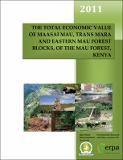The total economic value of Maasai Mau, Trans Mara and Eastern Mau forest blocks, of the Mau forest, Kenya
Author
Date
2011Type
Reportviews
downloads
Metadata
Show full item recordxmlui.dri2xhtml.METS-1.0.item-citation
The total economic value of Maasai Mau, Trans Mara and Eastern Mau forest blocks, of the Mau forest, Kenya
Abstract/
The Mau Forest Complex is the largest closed‐canopy forest ecosystem in Kenya comprising different forest blocks under different management regimes. The study covered three of the Mau Forest Complex blocks, i.e. Eastern Mau, Maasai Mau and Trans Mara. Of the three blocks, the Maasai Mau Forest is a trust land managed by the Narok County Council, and the other two are gazetted forests managed by the Kenya Forest Service (KFS) on behalf of the central government and they form the main catchment for the Mara River. The Mara River is the lifeline to a complex mosaic of ecological and economic systems that cut across its entire basin. The Mara River is a transboundary resource that serves key conservation areas both in Kenya and in Tanzania. Apart from serving the world famous Mara and Serengeti wildlife sanctuaries, the Mara River Basin provides critical ecological services in form of water storage; river flow regulation; flood mitigation; recharge of groundwater; reduced soil erosion and siltation; water purification; conservation of biodiversity; and microclimate regulation. The Mara River Basin and associated forests support key economic sectors such as energy, tourism, agriculture, industry and urban sanitation. The upper catchment also hosts the last group of hunter-gatherer forest dwelling communities, the Ogiek, and supports the livelihoods of communities living adjacent to forests through provision of material goods such as food; wood fuel; fodder; and building materials. The basin also generates global public goods/services such as wildlife conservation, carbon sequestration and biodiversity.

